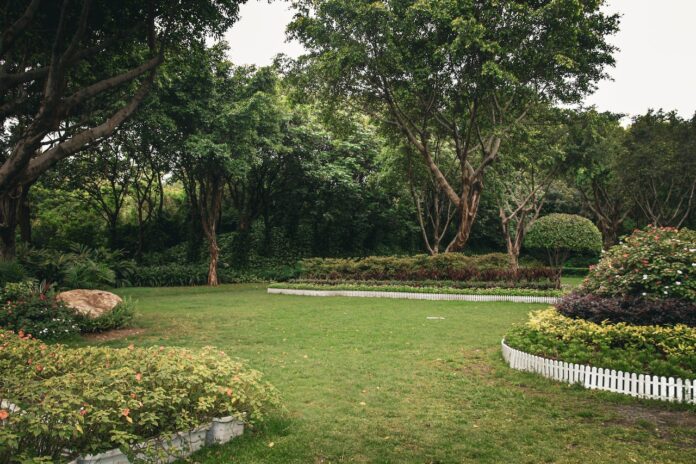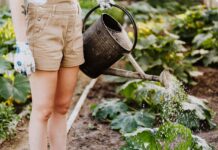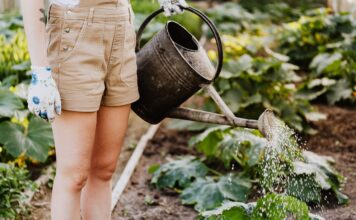In this comprehensive guide to planting and maintaining trees and shrubs, readers will learn about the numerous benefits of these plants, including their environmental, economic, social, and health advantages. The article offers advice on selecting the right species for specific sites, arranging trees and shrubs in gardens, and proper planting procedures. Additionally, readers will gain insights on watering and mulching practices, pruning and shaping techniques, fertilizing and soil management, pest and disease control, and long-term tree and shrub care. Whether you’re a seasoned gardener or a beginner, this article offers a wealth of information to help you successfully cultivate trees and shrubs in your landscape.
Benefits of Planting Trees and Shrubs
Environmental Benefits
Trees and shrubs offer numerous environmental benefits that are crucial for the well-being of our planet. One of their primary roles is the absorption of carbon dioxide (CO2) and the release of oxygen through the process of photosynthesis. This helps maintain a balance in the atmosphere and reduces the greenhouse effect, which contributes to global warming.
Furthermore, trees and shrubs act as natural filters, removing harmful pollutants from the air, such as nitrogen oxides, ammonia, and sulfur dioxide, by absorbing them through their leaves, bark, and roots.
In addition to improving air quality, trees and shrubs also play a vital role in preventing soil erosion. Their roots help to hold the soil in place, reducing the risk of landslides and preventing the loss of fertile topsoil, which is essential for agriculture. They also help maintain soil moisture, providing a more stable environment for other plants and animals to thrive.
Trees and shrubs are important for water filtration and conservation. They act as natural sponges, absorbing rainfall and reducing the risk of flooding. Their roots help filter pollutants from the water and stabilize soil, preventing harmful chemicals from entering waterways.
Lastly, trees and shrubs are essential for supporting biodiversity. They provide habitat and food for various species of plants, insects, birds, and mammals. Their presence can create microclimates that support different ecosystems, which promotes a healthy and balanced environment.
Economic Benefits
The presence of trees and shrubs can have significant economic benefits for both individuals and communities. Properties with well-maintained landscaping, including trees and shrubs, generally have higher market values than those without. As a result, the presence of trees and shrubs can enhance property values and improve the overall economic health of neighborhoods.
Additionally, trees and shrubs can lower energy costs by providing natural shade, which reduces the need for air conditioning in homes and buildings. They also act as windbreaks, reducing heating costs by reducing the impact of cold winds. Together, these energy-saving benefits can translate into substantial cost savings for homeowners and businesses.
Well-planted trees and shrubs can also improve the aesthetic appeal of public spaces, attracting tourists and enticing businesses to invest in the area. This, in turn, can lead to increased job opportunities, a more vibrant economy, and an overall improvement in the quality of life for residents.
Social Benefits
Having access to green spaces, including areas with trees and shrubs, has been shown to improve mental and emotional well-being. People who spend time in natural environments tend to experience reduced stress levels, improved mood, and increased social interactions. This can lead to a stronger sense of community and increased social cohesion within neighborhoods.
Furthermore, trees and shrubs can contribute to noise reduction, creating more peaceful and enjoyable outdoor spaces. They act as sound barriers, absorbing and deflecting noise pollution from traffic, industry, and other urban sources.
Lastly, the presence of trees and shrubs in urban areas can contribute to increased safety. Well-lit and well-maintained green spaces can deter criminal activity, making neighborhoods more secure and fostering a sense of safety among residents.
Health Benefits
Trees and shrubs can have a positive impact on both physical and mental health. Research has shown that individuals who have access to green spaces experience lower levels of stress and anxiety, which can lead to lower rates of depression and other mental health issues.
Moreover, exposure to trees and green spaces has been linked to a reduction in respiratory illnesses, such as asthma, as well as improved cardiovascular health. The cleaner air provided by trees and shrubs, as well as the encourage of outdoor physical activities that green spaces offer, can have long-term health benefits.
Finally, trees and shrubs can provide natural shade, reducing exposure to harmful ultraviolet (UV) radiation from the sun. Proper shading can help protect against skin cancer and other negative health effects associated with excessive sun exposure.
In summary, planting trees and shrubs provides numerous benefits for the environment, economy, society, and personal health. These benefits make it essential to prioritize and invest in urban forestry and green spaces in our communities.
Selecting the Right Tree or Shrub
Before you start planting trees and shrubs, it’s essential to select the right type for your specific needs and environment. This will not only ensure that your plants thrive and grow but also that they contribute positively to your landscape and the local ecology. This article will discuss how to assess site conditions, consider size and growth rate, plan for seasonal changes, and choose between native and non-native species.
Assessing Site Conditions
To successfully grow trees and shrubs, you must carefully assess the site conditions and choose plants that are well-suited for that environment. Factors to consider include:
- Soil: Analyze the soil type, pH, and drainage. Some species prefer sandy or clayey soils while others require well-drained or slightly moist conditions.
- Sunlight: Determine the amount of sunlight your site receives daily. Some plants thrive in full sun, while others require shade or partial shade.
- Wind: Identify wind patterns and choose species that can withstand strong gusts or those that function as windbreaks.
- Surrounding vegetation: Research the types of plants that grow naturally in your area and plan your vegetation accordingly.
- Space constraints: Measure available space for planting to ensure you choose appropriate-sized species.
- Hardiness zone: Understand the USDA Plant Hardiness Zone for your location to match species that can tolerate the local climate, including winter temperatures.
Size and Growth Rate Considerations
When selecting trees and shrubs, it’s essential to take into account their mature size as well as growth rate. Consider the following factors:
- Mature size: Choose species with a mature size that fits in the available space to avoid overcrowding, structural damage, or excessive pruning.
- Canopy spread: Consider the width of the tree canopy at maturity, as it impacts other plants, buildings, and landscape elements.
- Growth rate: Fast-growing species can provide quick shade and privacy, but may have shorter lifespans and require more maintenance. Slow-growing species are often more durable but require patience.
- Root systems: Some species have aggressive root systems that can cause damage to foundations, plumbing, or sidewalks. Research your chosen species and ensure their roots won’t cause future problems.
Planning for Seasonal Changes
As you plan your yard, it’s important to consider how trees and shrubs will look and function during different seasons. Keep these points in mind:
- Flowering and fruiting seasons: Align planting schedules with flowering and fruiting times to ensure ample blooms and reduce the risk of disease or pests.
- Foliage color: Choose species with a variety of foliage colors and textures to create visual interest throughout the year.
- Fall foliage: Consider deciduous species with vibrant fall colors to add seasonal appeal.
- Winter interest: Select evergreens or trees with significant branch structures to provide visual interest during bare winter months.
- Seasonal care: Plan for the changing maintenance requirements of different species throughout the year, such as pruning, fertilizing, and watering.
Native vs. Non-Native Species
When selecting trees and shrubs, consider whether you want to utilize native or non-native species. Each type has its advantages and disadvantages:
- Native species: Planting native trees and shrubs can support local ecosystems and wildlife, provide habitat, and generally require less water and maintenance than non-native species. Additionally, native plants are often more resistant to local pests and diseases.
- Non-native species: While non-native plants can provide interesting visual elements and diversity to your landscape, they also pose some risks. Invasive species can outcompete native plants and disrupt the balance of the ecosystem. Always research and select non-native species carefully to avoid introducing harmful plants into your environment.
By considering site conditions, size and growth rate, seasonal changes, and native versus non-native options, you can create a beautiful, sustainable, and low-maintenance landscape—full of trees and shrubs tailored to meet your specific needs and environmental conditions.
Planting Tree and Shrub Species in Gardens
Trees and shrubs play vital roles in gardens. They provide structure, beauty, shade, and habitat for wildlife while also offering privacy and helping to reduce air and noise pollution. When choosing and planting tree and shrub species for your garden, it’s important to consider their characteristics, suitability for your space and needs, and how they will impact the overall design of your garden. In this article, we’ll discuss how to select the right tree and shrub species for your garden, their arrangement, and companion planting and design ideas.
Choosing the Right Tree Species for Your Garden
Selecting the right tree species for your garden is essential to ensure the health and longevity of the tree and to create a harmonious landscape design. Here are some factors to consider when selecting tree species for your garden:
- Climate and soil conditions: Some trees are better suited to specific climates, while others can adapt to a wide range of temperatures and environmental situations. The same goes for soil conditions – some trees need well-drained soil, while others can tolerate wet or heavy clay soil. Always choose trees that are well suited to your local climate and soil conditions.
- Size and growth rate: Consider the mature size of the tree and its growth rate when selecting a species for your garden. Some trees may grow too large for your space, while others may take too long to reach their mature size. Choose a tree that will fit comfortably within your garden when fully grown.
- Maintenance and care requirements: Some tree species require more care and maintenance than others. Consider the level of effort you are willing to put into caring for your tree, and choose a species that matches your commitment.
- Function and aesthetics: Think about what you want the tree to do in your garden. Will it provide shade, privacy, shelter for wildlife, or simply serve as an ornamental feature? Consider the tree’s shape, foliage, and overall aesthetics when making your selection.
Choosing the Right Shrub Species for Your Garden
Like trees, selecting the right shrub species for your garden is crucial for the overall success of your landscape design. Here are some factors to consider when selecting shrub species for your garden:
- Climate and soil conditions: As with trees, choose shrubs that are well suited to your local climate and soil conditions. Some shrubs may not survive in colder climates, while others may not tolerate high levels of heat or drought.
- Size and growth rate: Keep in mind the mature size of the shrub and its growth rate. Some shrubs can grow quite large and may overcrowd your garden, so choose species that will remain appropriately sized for your space.
- Maintenance and care requirements: Some shrubs need regular pruning and maintenance, while others are low-maintenance choices. Choose shrub species that match your willingness to provide care and upkeep.
- Function and aesthetics: Determine the purpose of the shrub in your garden. Will it serve as a focal point, a screen or border, or simply as an attractive addition to your landscape? Consider the shrub’s form, foliage, and flowers when making your selection.
Arranging Trees and Shrubs in the Garden
The arrangement of trees and shrubs in your garden can greatly impact its overall look and functionality. Here are some tips for arranging trees and shrubs in your garden:
- Groupings and layers: To create a more natural, cohesive look, group trees and shrubs together in informal clusters. This can be particularly effective when you’re incorporating species with different heights, as multiple layers can create depth and visual interest.
- Planting for privacy and screening: Trees and shrubs can be planted as hedges, screens, or buffers to create privacy and reduce noise. Consider evergreen varieties, as they will maintain their foliage throughout the year.
- Focal points and specimen plants: Highlight special or unique trees and shrubs by planting them as focal points or specimen plants. This can be particularly effective when using trees and shrubs with unique architectural forms, striking foliage, or colorful flowers.
Companion Planting and Design Ideas
Using companion planting techniques and thoughtful design, you can create a harmonious garden that not only looks beautiful but also supports the health of your trees and shrubs. Here are some ideas for companion planting and design:
- Planting for pollinators: Attract pollinators like bees, butterflies, and hummingbirds by incorporating flowering trees, shrubs, and perennials throughout your garden. This not only supports the health of your plants through increased pollination but also creates a beautiful, lively space.
- Planting for pest control: Encourage natural predators to help control pests in your garden by incorporating trees and shrubs that provide cover, shelter, and food for beneficial insects and wildlife.
- Designing for seasonal interest: Select tree and shrub species that offer year-round beauty through varied foliage, flowers, berries, and bark. This can provide a dynamic, ever-evolving landscape that’s pleasing to the eye throughout the year.
- Creating thematic gardens: If you have a specific theme in mind for your garden (such as a native plant garden or a woodland garden), select trees and shrubs that fit within that theme and have complementary features. This can create a cohesive design that reflects your personal interests and passions.
Planting Procedures
Choosing the Best Time to Plant
The timing of when to plant a tree or shrub is crucial for its successful growth and development. Ideally, trees and shrubs should be planted during their dormant season in order to minimize stress and maximize root growth before leaves emerge. For most species, this means planting in the fall, after leaf drop, or in early spring, before bud break.
Fall planting allows for the establishment of roots before winter, providing the plant with a head start for the following growing season. Soil temperatures are also warmer in the fall, which encourages root growth. Fall planting is especially beneficial for plants that have larger root systems or are slower to establish, such as certain tree species.
Spring planting can also be successful, but it’s important to plant early in the season to avoid hot, dry summer weather, which can cause additional stress on newly planted trees and shrubs. Additionally, be cautious of planting too early in the spring, as late frosts can potentially damage newly emerged foliage.
Preparing the Planting Site
Proper site preparation is essential for the successful growth and establishment of trees and shrubs. First, choose a location with adequate sunlight, good drainage, and enough space for the mature size of the plant.
Before planting, clear the area of any debris or weeds that could hinder the success of the new plantings. Additionally, amending the soil can be beneficial for growth, especially if the existing soil is lacking in organic matter or has poor drainage.
When digging the planting hole, make sure it is at least two to three times wider than the root ball or container of the plant, and no deeper than the root ball. This wide hole allows for adequate room for the roots to spread and establish themselves.
Handling and Planting Container-Grown Trees and Shrubs
When handling container-grown plants, it’s important to protect the root system from damage. Gently remove the plant from its container, taking care not to break the root ball. If the roots are tightly bound, carefully loosen and untangle them to encourage outward growth.
Place the container-grown plant in the prepared hole, ensuring that the top of the root ball is level with the ground. Fill the hole with the removed soil, gently firming it around the roots to eliminate air pockets. Water the plant thoroughly to settle the soil and establish good root-to-soil contact.
Handling and Planting Bare-Root Trees and Shrubs
Bare-root trees and shrubs are typically available during the dormant season and should be planted soon after purchase. Before planting, soak the roots in water for several hours to prevent them from drying out.
When planting, create a cone-shaped mound of soil at the bottom of the hole to support the root system. Spread the roots evenly over the mound, ensuring that they are not twisted or crowded. Fill the hole with soil, gently tamping it down to eliminate air pockets.
Ensure that the plant’s root collar – the point where the roots meet the trunk – is level with the ground. Water the plant thoroughly to settle the soil and establish good root-to-soil contact.
Staking and Supporting Newly Planted Trees
Staking is sometimes necessary to provide support and stability for newly planted trees. However, it should only be done if the tree cannot stand upright on its own or if it is in a high-wind area.
When staking a tree, drive two or three stakes outside the planting hole and use soft, wide material such as tree ties or strips of cloth to attach the tree to the stakes. Avoid using narrow wire or rope as they can cut into the bark and cause damage over time.
It is important not to stake a tree too tightly, as this can restrict trunk movement and discourage the development of strong wood. The tree should still be able to move slightly in the wind for natural strengthening. Stakes should be removed as soon as the tree can support itself, usually within one to two years after planting.
Watering and Mulching
Watering and mulching are two essential gardening practices that help in maintaining healthy plants and trees in your garden. These practices not only improve the soil quality but also save time and resources by reducing the need for frequent watering and weed management. In this article, we will discuss proper watering techniques, how to establish a watering schedule, choosing and applying mulch materials, and discuss the benefits and tips for mulching.
Proper Watering Techniques
Proper watering techniques will ensure that your plants receive the right amount of water, avoiding over-watering or under-watering. Through these methods, you can make your watering more efficient and effective. Some of the best practices for watering include:
- Water at the right time: The ideal time for watering plants is during the early morning or late evening when temperatures are cooler. Watering at these times reduces evaporation, allowing the plants to absorb more water.
- Water at the roots: Instead of sprinkling water over the entire plant, focus on watering the root zone. This will encourage the roots to grow deeper, leading to healthier and more drought-resistant plants. Use drip irrigation or a soaker hose for better root watering.
- Use a rain gauge: A rain gauge is a simple tool that measures rainfall. Use it to monitor the amount of rain your garden receives, and adjust your watering schedule accordingly.
- Avoid over-watering: Over-watering can lead to root rot and other issues. To prevent this, always check the soil moisture before watering your plants. The soil should be moist but not saturated.
Establishing a Watering Schedule
A watering schedule is crucial in maintaining the health of your plants. To establish a watering schedule, consider the following factors:
- Plant type: Different plants have different water requirements. Some plants need frequent watering, while others can tolerate dry soil for extended periods. Research the specific needs of the plants in your garden.
- Soil type: The type of soil in your garden will affect the frequency of watering. Sandy soils drain water quickly, requiring more frequent watering than clay soils.
- Climate: The climate in your area will be a significant factor in determining your watering schedule. Hot and dry climates will require more frequent watering, while cooler, wetter regions will require less.
- Microclimates: Different areas within your garden may have different microclimates. Sun-exposed areas may need more frequent watering than shaded locations.
Monitor plant health and adjust the watering schedule accordingly. Regularly checking soil moisture and observing plant growth can help you fine-tune your watering schedule as needed.
Choosing and Applying Mulch Materials
Mulch is a protective layer of material spread on top of the soil, helping to conserve moisture, suppress weeds, and maintain soil temperatures. There are various mulch materials available, such as wood chips, shredded bark, grass clippings, leaves, straw, and compost.
When choosing a mulch material, consider factors such as the type of plants in your garden, the desired appearance, and the cost of the material. Organic mulches like wood chips and shredded bark are suitable for almost all plants, while grass clippings and straw are best for vegetable gardens.
To apply mulch, spread a 2-4 inch layer around the base of your plants, making sure not to place the mulch directly against plant stems, as this may cause rot. Replenish mulch as necessary, usually once or twice a year, to maintain the desired thickness.
Mulching Benefits and Tips
Mulching offers various benefits to your garden, such as:
- Reducing water evaporation: Mulch helps conserve soil moisture by reducing evaporation due to sunlight and wind.
- Suppressing weeds: A layer of mulch will prevent weed seeds from germinating and competing with your plants for resources.
- Regulating soil temperature: Mulch can help protect plant roots from extreme temperature fluctuations.
- Improving soil structure: Organic mulches like wood chips and compost break down over time, releasing nutrients and improving soil structure.
Some additional tips for effective mulching include:
- Avoid using inorganic mulches like plastic and rubber, as they do not contribute to soil health and can be difficult to dispose of.
- Do not create a “mulch volcano” by piling mulch around tree trunks. This can lead to root rot and other problems.
- Keep mulch away from the stems of plants and tree trunks to prevent rot and disease.
By following these watering and mulching practices, you can maintain a healthy and thriving garden while conserving resources and minimizing time spent on maintenance.
Pruning and Shaping Trees and Shrubs
Understanding the Purpose of Pruning
Pruning and shaping trees and shrubs are essential aspects of maintaining a healthy and aesthetically pleasing landscape. The primary purposes of pruning include promoting plant health, maintaining safety, enhancing the aesthetic value, and controlling the size and shape of trees and shrubs.
By removing dead or diseased branches, pruning helps prevent the spread of disease and insect infestations. Eliminating crossing or rubbing branches reduces the potential for damage and decay, while removing weak or narrow-angled branches enhances the plant’s overall structure and strength. Regular pruning also encourages vigorous growth, leading to healthier and more productive plants.
Maintaining safety through pruning is crucial, particularly for large trees near structures or power lines. Removing low-hanging or obstructing branches can improve visibility and access in gardens, pathways, and driveways. In addition, eliminating potentially hazardous branches that could fall during storms or as a result of decay helps prevent damage to property and injury.
Aesthetic pruning focuses on maintaining the natural form and enhancing the visual appeal of trees and shrubs. This involves removing unsightly branches, suckers, or shoots and creating a balanced canopy for trees or a uniform shape for hedges and shrubs. Regular shaping of plants contributes to an attractive and cohesive landscape design.
Tools and Techniques for Pruning
When pruning trees and shrubs, having the right tools is essential for effective and efficient work. Essential pruning tools include hand pruners, loppers, pruning saws, pole pruners, and hedge shears. Hand pruners are ideal for small branches up to 1 inch in diameter, while loppers can handle branches up to 2 inches thick. Pruning saws are used for larger branches, and pole pruners enable the user to reach high branches without a ladder. Hedge shears are perfect for shaping hedges and large shrubs.
Some common pruning techniques include thinning, heading back, and shearing. Thinning involves the removal of entire branches or stems to decrease density, create an open structure, and prevent overcrowding. Heading back cuts are used to shorten branches, limit growth, and encourage branching. Shearing is mainly used for shaping hedges and shrubs, and involves trimming the outer layer of foliage to create clean lines and shapes.
Shaping Shrubs and Hedges
To achieve a neat and well-maintained appearance, regular shaping of shrubs and hedges is essential. Hedges are often shaped into formal, geometric designs, while shrubs may be shaped more informally or grown into specific forms, such as topiary.
When shaping, start by removing any dead, damaged, or diseased branches. Then, use hedge shears or pruners to cut back the remaining branches, following the natural growth direction and angle of the stems. For formal hedges, guidelines can be helpful in maintaining straight lines and ensuring symmetry. Informal shaping of shrubs often involves selectively cutting individual branches to maintain the plant’s form.
Pruning Trees for Optimal Structure and Growth
Proper pruning is crucial for maintaining strong and healthy trees. Begin with the removal of dead, damaged, or diseased branches. Remove crossover branches and suckers to minimize rubbing, allowing for growth in the desired direction. Pay special attention to weak, narrow-angled branches, which are susceptible to breakage.
Structural pruning techniques can be employed to maintain a single central leader, establish strong scaffold branches, and create an open, balanced canopy. This should be done while the tree is young to prevent issues in later years. Regular pruning in the early years of a tree’s growth encourages a resilient and attractive structure.
Timing of Pruning and Maintenance
The timing of pruning and maintenance for trees and shrubs is crucial for their health and is largely dependent on the plant species and its growth habits. In general, the best time to prune most trees and shrubs is during dormant seasons, early winter or early spring, as this promotes vigorous new growth.
For flowering trees and shrubs, pruning should be done based on whether they bloom on old or new wood. Spring-flowering plants that bloom on old wood should be pruned after the flowers have faded, while summer-flowering plants that bloom on new wood should be pruned before the new growth starts in the spring.
Some tree species, such as oak, elm, and birch, are best pruned during their dormant period to avoid attracting harmful insects or disease. Regular maintenance is crucial for keeping trees and shrubs healthy and attractive, ensuring a well-maintained landscape that thrives for years to come.
Fertilizing and Soil Management
Proper soil management is critical to the success of any garden or agricultural endeavor. Understanding how soil fertility works, the essential nutrients plants require and how to amend soil to improve nutrient availability are all important aspects of maintaining healthy, productive plants. This article will provide an overview of basic fertilizing and soil management principles, including identifying essential nutrients, selecting and applying fertilizers, using organic soil amendments, and monitoring and adjusting soil pH.
Essential Nutrients and Soil Requirements
Plants require a number of essential nutrients in order to grow and thrive. These nutrients, broken down into macronutrients and micronutrients, play a major role in plant development, reproduction, and overall health. Macronutrients are required in larger amounts and include nitrogen (N), phosphorus (P), and potassium (K), while micronutrients, needed in smaller amounts, include elements such as iron, manganese, zinc, and copper.
Soil fertility refers to the ability of the soil to supply the nutrients needed for optimal plant growth. Soil organic matter plays a vital role in providing and holding these needed nutrients. Soil should be fertile in order to support healthy plant growth, and it is essential to understand the nutrient content of your soil for proper fertilizing and soil management.
Soil testing is the best way to determine nutrient availability, pH levels, and other factors affecting plant growth. A soil test will provide specific recommendations for amending the soil based on the needs of the plants you are growing.
Selecting and Applying Fertilizers
The fertilizers you choose and how you apply them will depend on a variety of factors, including plant type, specific nutrient requirements, and your personal gardening preferences. Fertilizers come in a range of forms, including granular, liquid, powder, or slow-release, and can be organic (derived from plant or animal sources) or inorganic (synthetic chemicals).
Fertilizers should be selected based on the nutrients they provide and should be tailored to the specific needs of your plants. In general, gardeners should look for fertilizers containing the three primary macronutrients – nitrogen, phosphorus, and potassium (often abbreviated as N-P-K on fertilizer packaging). The ratio of these nutrients, such as 10-10-10 or 20-10-10, indicates the percentage of each nutrient in the product.
It is vital to apply fertilizers according to the manufacturer’s recommendations to avoid over-fertilizing or inefficient nutrient use. The best time to fertilize is typically at the beginning of the growing season or during periods of active growth. Fertilizer application should be accompanied by adequate watering, as this helps to dissolve and transport nutrients to plant roots.
Organic Soil Amendments and Composting
Organic soil amendments are materials derived from plant, animal, or mineral sources added to soil in order to improve fertility and structure. Common organic amendments include compost, aged manure, peat moss, and shredded leaves. Using organic amendments can help improve soil nutrient content, drainage, and overall structure, leading to healthier plants and increased productivity.
Composting involves the natural decomposition of organic materials, resulting in a nutrient-rich product that can be added to garden soils. Compost can boost soil fertility, improve soil structure and drainage, and provide additional nutrients and trace minerals needed for plant growth. Adding compost to the soil is one of the best ways to create healthy, productive growing conditions while also reducing waste and recycling kitchen and garden scraps.
Monitoring and Adjusting Soil pH
Soil pH is a measure of the acidity or alkalinity of the soil, and it can have a significant impact on nutrient availability and overall plant health. Most plants prefer soil with a slightly acidic pH between 6.0 and 7.0, but certain species may require different conditions. Monitoring and adjusting soil pH as needed is an essential component of good soil management.
Soil testing, as mentioned earlier, will typically provide pH values and recommendations for amendments to adjust it if necessary. Common amendments for raising soil pH (making it more alkaline) include lime and wood ash, while amendments for lowering pH (making it more acidic) include sulfur and aluminum sulfate.
Amending soil pH should be done gradually and with care, as overly acidic or alkaline environments can harm plant health. Additionally, it is important to account for the specific pH preferences of the plants you are growing, to ensure that your soil amendments are creating the optimal environment for their growth and development.
Pest and Disease Control
Identifying Common Tree and Shrub Pests
The first step in pest and disease control is to accurately identify the pests that may be infesting your trees and shrubs. There are many pests that can cause damage to your plants, and it is important to know which ones are present in your area.
One common pest that can be found on a variety of tree species is the scale insect. Scale insects feed on the sap of trees, leading to weakened trees and potentially even tree death. Some of the most common types of scale insects include the soft scale, armored scale, and the white wax scale.
Aphids are also common pests found on trees and shrubs. These small, soft-bodied insects feed on plant sap and can cause leaves to curl, wilt, and turn yellow. Aphids can also produce a sticky substance called honeydew, which can attract other pests such as ants and promote the growth of mold.
Another common pest is the spider mite. These tiny pests feed on plant tissue, causing leaves to become discolored, speckled, and eventually fall off. Spider mites can be difficult to see with the naked eye but can cause significant damage to trees and shrubs if left unchecked.
The larvae of the tent caterpillar can also cause significant harm to various species of trees. These pests form silk tents in the branches of trees, where they feed on leaves, eventually defoliating the trees and leading to potential tree death.
Preventative Care and Maintenance
A key to effective pest and disease control is practicing preventative care and maintenance. By properly caring for your trees and shrubs, you can help to prevent diseases from taking hold and mitigate the risk of pest infestations.
One important aspect of preventative care is proper watering. Make sure to water your trees and shrubs deeply and infrequently to promote strong root growth and to prevent water stress. Proper mulching around the base of your trees can also help to retain moisture and reduce water stress.
Fertilizing your trees and shrubs can also promote healthy growth, making them less susceptible to pests and diseases. Be sure to use the appropriate type of fertilizer for each type of tree or shrub and avoid over-fertilizing, which can lead to weak, excessively lush growth that is more susceptible to pests.
Pruning your trees and shrubs properly can also help to maintain their overall health and reduce the risk of pest infestations. Make sure to remove any dead or infected branches and maintain proper spacing between plants to encourage good air circulation.
Monitoring and Managing Pests
Regular monitoring of your trees and shrubs is essential for early detection and management of pests. Inspect your plants closely on a regular basis, looking for any signs of pest activity, such as discolored leaves, webbing, or frass (insect waste). In addition to visual inspections, you may also consider using pheromone traps or sticky traps to monitor for specific pests.
When managing pests, it is important to use the least toxic approach first. Many pests can be managed through cultural, biological, and mechanical methods. For example, you can manually remove and destroy tent caterpillars, their tents and egg masses, or you can release natural predators, such as ladybugs or lacewings, to help control aphids.
If these methods are insufficient, you may need to consider using chemical methods for pest control. Be sure to use insecticides that are labeled for use on your specific plant species and follow label instructions carefully.
Recognizing and Treating Tree and Shrub Diseases
In addition to pests, trees and shrubs can also be affected by various diseases. Some common tree and shrub diseases include fungal diseases, such as powdery mildew and rust, and bacterial diseases, such as fire blight and bacterial leaf scorch.
The first step in treating tree and shrub diseases is to properly diagnose the problem. This is often done by examining the symptoms of the affected plants and may be confirmed through laboratory testing.
Once the disease has been identified, you can begin treatment, which will depend on the specific disease affecting your tree or shrub. For some fungal diseases, fungicides may be effective in treating the issue. Be sure to select the appropriate fungicide for your specific disease and follow label instructions carefully.
In some cases, it may be necessary to remove and destroy affected branches or even the entire tree or shrub to prevent the spread of the disease. If the disease is bacterial in nature, antibiotic treatments may be helpful, although these treatments are less common and not available for all bacterial diseases.
Preventative measures, such as proper care and maintenance, can also help to reduce the risk of diseases taking hold in your trees and shrubs. By maintaining a healthy environment for your plants, you can help to minimize the likelihood of diseases causing significant problems in your landscape.
Tree and Shrub Care for Longevity
Caring for trees and shrubs is essential to ensure their longevity and promote the health and sustainability of the plants. This involves protecting them from damage, managing damage caused by storms, and regularly maintaining their health and appearance.
Protecting Trees and Shrubs from Damage
There are several factors that can cause damage to trees and shrubs, and taking preventative measures can help increase their lifespan in your landscape.
- Pest control: Pests such as insects, rodents, and diseases can cause serious damage to trees and shrubs. Monitor your plants regularly for signs of infestation or disease and take appropriate action, such as applying insecticides, fungicides or other treatments to control the issue.
- Mulching: Applying mulch around the base of trees and shrubs helps to regulate soil temperature, retain moisture, and suppress weed growth. When applied properly, mulch also helps prevent damage from lawn mowers and string trimmers.
- Watering: Proper watering is essential for healthy plant growth. Too much or too little water can lead to root problems and weakened plants, making them more susceptible to damage. Be sure to water deeply and infrequently, allowing the soil to dry out between waterings to encourage deep root growth.
- Fertilizing: Providing trees and shrubs with appropriate nutrients helps promote healthy plant growth and increases their ability to withstand damage. Test your soil to determine the appropriate nutrients needed and use the recommended fertilizer ratio for your specific plants. Be careful not to over-fertilize, as this can lead to excessive growth, which can increase vulnerability to pests and diseases.
- Pruning: Regular pruning is necessary to remove dead, damaged, or diseased branches and promote proper plant growth. Pruning also helps to create a strong, well-structured plant with a reduced risk of breaking or splitting during storms.
Managing Storm Damage and Recovery
Storms can cause significant harm to trees and shrubs, but with proper care and management, recovery is possible.
- Assess the damage: After a storm, carefully inspect your plants for broken or damaged branches. Avoid immediate pruning if it is not safe or if the tree is still unstable, as it may further damage the plant.
- Remove debris: Clear fallen branches and leaves from your property as soon as possible to prevent further damage to your trees and shrubs. This will also help reduce the risk of pests and diseases taking advantage of the damaged plants.
- Pruning: Once it is safe to do so, remove any broken or damaged branches to help the tree or shrub recover more quickly. Be sure to make clean cuts at the branch collar, taking care not to cut too close to the trunk, which can cause further injury.
- Support: If a tree or large shrub is leaning due to storm damage, stake it or provide support to help it regain its proper position. Be sure to monitor the plant for any signs of stress or further damage while it is supported.
- Time and patience: Recovery from storm damage can take time. Monitor your plant’s progress and provide appropriate care, such as watering and fertilizing, to help it regain its strength and grow healthily.
Maintaining Tree and Shrub Health and Appearance
Regular maintenance of your trees and shrubs keeps them healthy and looking their best.
- Pruning: Regularly prune your trees and shrubs to remove dead, damaged, or diseased branches, as well as any crossing or competing branches. Pruning also helps to maintain the desired shape and size of the plant.
- Watering: Proper watering is key to maintaining healthy plants. Deeply water your trees and shrubs, allowing the soil to dry out before watering again. Adjust your watering schedule based on weather conditions, as plants require more water during hot, dry periods and less during cool, damp weather.
- Fertilizing: Feed your trees and shrubs with the appropriate nutrients based on soil testing and plant requirements. Remember that over-fertilizing can harm your plants, so only apply as needed.
- Disease and pest control: Monitor your plants for signs of diseases and pests, and take appropriate action to control and prevent further issues.
- Mulching: Maintain a layer of mulch around your trees and shrubs to help regulate soil temperature, retain moisture, and suppress weed growth.
By following these tree and shrub care tips, you can help ensure their longevity, health, and beauty in your landscape.
What is the ideal time for planting trees and shrubs?
The optimal time for planting trees and shrubs is during the months of early spring or fall. Soil temperatures and moisture levels are generally more favorable during these seasons, leading to healthier root development and increased establishment in the landscape.
What factors should be considered when choosing trees and shrubs to plant?
Select trees and shrubs based on the site’s soil type, sunlight, temperature range, moisture levels, and available space. Additionally, consider the plants’ growth habit, disease resistance, wildlife benefits, and the desired aesthetic or functional role in the landscape.
How deep and wide should the holes be dug for planting trees and shrubs?
For most trees and shrubs, dig a planting hole two to three times the width of the root ball or container. The depth should at least be equal to the height of the root ball or container, ensuring that the top of the root ball is slightly above or level with the surrounding soil.
What is the importance of mulching around newly planted trees and shrubs?
Mulching provides multiple benefits for newly planted trees and shrubs, including conserving soil moisture, regulating temperature, inhibiting weed growth, and preventing soil erosion. Additionally, organic mulch improves soil structure and fertility as it decomposes over time.
What is the appropriate irrigation frequency and volume for newly planted trees and shrubs?
Monitor soil moisture and provide supplemental water when necessary, aiming for a moisture level that is consistently moist but not saturated. Newly planted trees and shrubs typically require more frequent watering than established plants. Apply an adequate volume of water to moisten the root zone.
How should trees and shrubs be pruned after planting?
After planting, remove broken, dead, or diseased branches on trees and shrubs. For young trees, limit additional pruning to maintain a strong central leader and proper branch spacing. For shrubs, wait until the plant has established itself to perform any major pruning, and always follow appropriate pruning techniques for the specific plant species.












